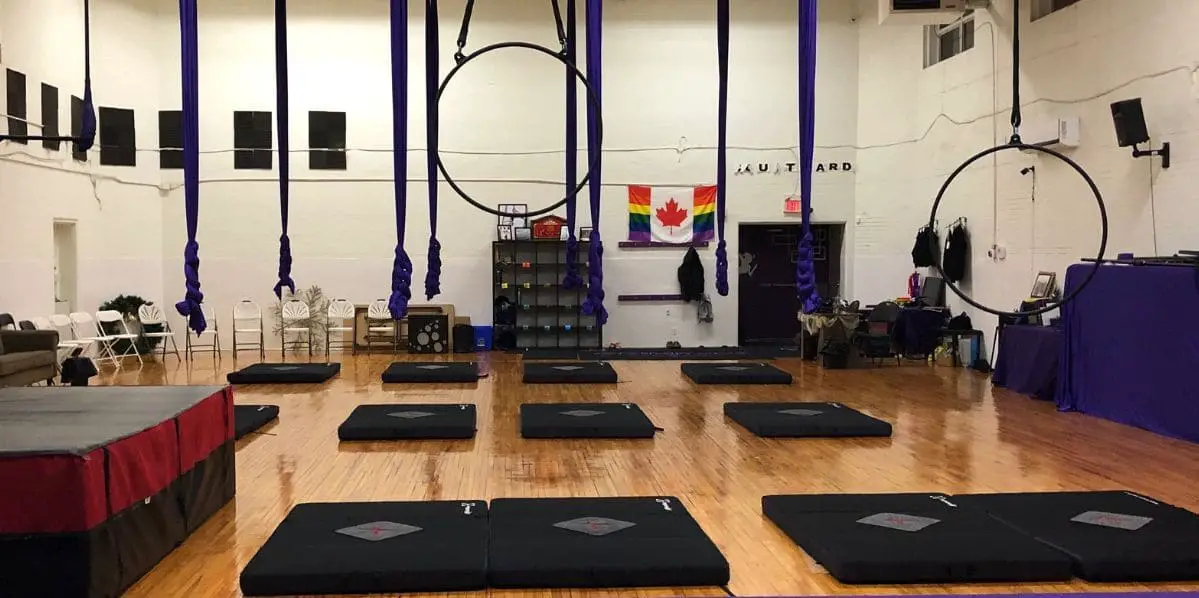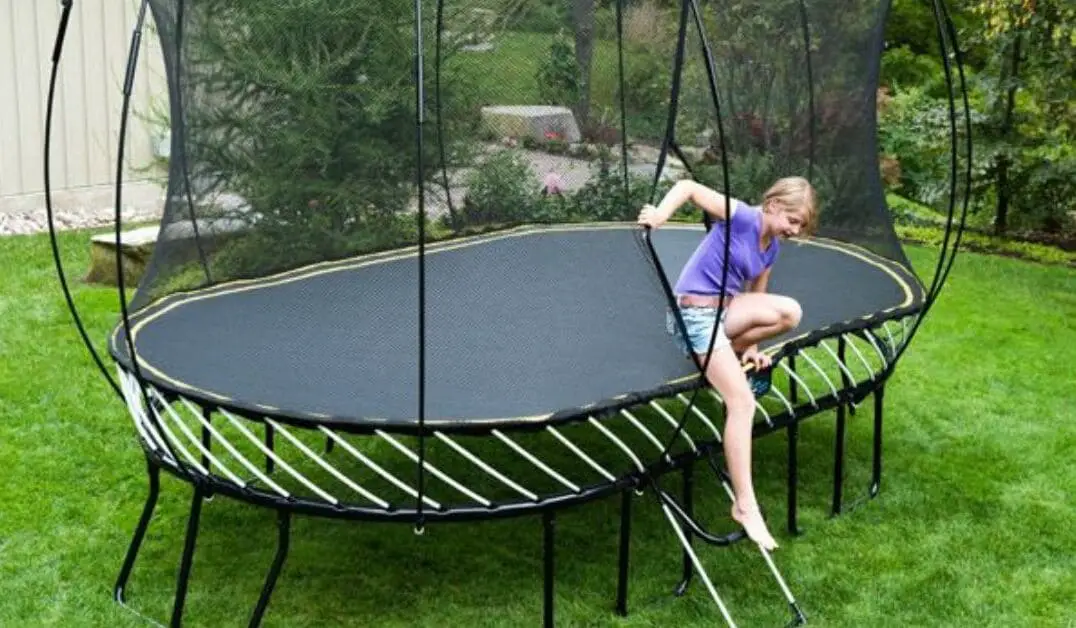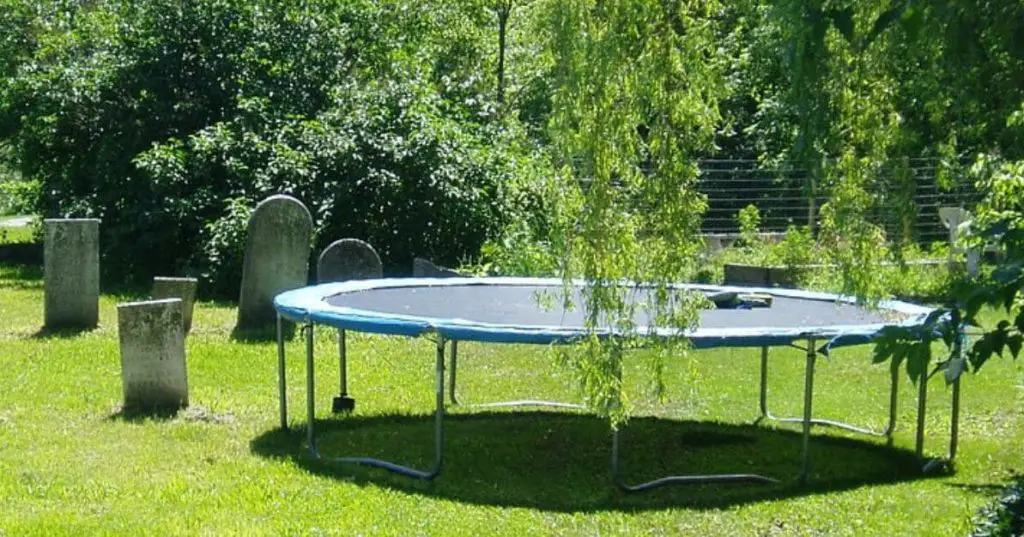I can tell you that trampolines are typically made of high-quality materials that are carefully chosen to ensure durability, safety, and optimal performance.
The frame of a trampoline is typically made of sturdy materials like steel or aluminum, which provide the necessary strength and stability to support the weight of jumpers and withstand the forces generated during bouncing.
The springs are usually made of durable steel, carefully designed to provide the right amount of tension for a good bounce. The jumping surface, often made of polypropylene or polyethylene, is carefully woven to create a smooth, strong, and responsive surface for jumping.
To ensure safety, trampolines often come with a safety enclosure made of mesh or netting, which is designed to prevent falls and injuries.
The padding and cover materials, typically made of foam and PVC, provide additional protection around the frame and springs to prevent accidental contact with hard surfaces.
High-quality trampolines are designed to be weather-resistant, with materials that are UV-resistant and durable to withstand exposure to the elements.
Some trampolines also come with additional features such as rust-resistant coatings or galvanized steel frames to enhance their durability and longevity.
In this article, we will discuss “What is a trampoline made of”?
What is a Trampoline Made of? Trampolines are typically made of steel or aluminum frames, durable springs, polypropylene or polyethylene jumping surfaces, safety enclosures, and foam/PVC padding.
What are the materials used to make trampolines?
We need to understand that trampolines are made of more than just metal. They also have a specific type of fabric that makes up the jumping surface. So, what is this fabric made of? Is it just a regular mat, or is there something unique about it?
What are Trampoline Frames Made Of?
Trampoline frames are typically made of galvanized steel. This type of steel is used because it is resistant to rust and can withstand various weather conditions, making it ideal for outdoor use.
Galvanized steel helps ensure that the trampoline remains in good condition, regardless of rain or shine, and maintains its appearance over time.
The Trampoline Mat Material

The trampoline mat, where all the jumping happens, is often made of polypropylene fabric. This tightly webbed fabric is not only durable and strong but also smooth and flexible, providing a safe surface for hours of jumping fun.
It is designed to handle tough environments and eager children, while also being UV-resistant, mildew-resistant, and anti-slip. The smooth surface of the fabric ensures that it won’t hurt our feet while jumping, and its flexibility provides the perfect bounce every time.
Whether used indoors or outdoors, this fabric is a safe and reliable choice for trampoline mats, providing a fun and secure jumping experience for everyone.
What Metal Are Trampolines Made Of?
Trampolines are typically made of steel to ensure durability and stability. Steel, which is an alloy of iron and carbon, provides a solid construction that can withstand lots of jumping.
Knowing that a trampoline is made of steel gives peace of mind to many people, as it is robust and safe. Steel trampolines are built to last for years, maintaining their condition even with regular use.
What is Trampoline Springs Made Of?
Trampoline springs are what give a trampoline its bounce, not the mat. These springs are typically made of galvanized steel, just like the tubing, to ensure durability and resistance to rust.
The number and type of springs used in a trampoline are determined by the manufacturer, and some trampolines may even use elastic bands instead of springs. However, elastic bands are not as effective as springs, as they can lose their bounce quickly.
It’s important to consider the type and quality of springs used in a trampoline when looking for one that provides a fun and safe bouncing experience.
Understanding the Tubing Structure
The structure and legs of a trampoline are made of tubing, which can come in different sizes depending on the trampoline model. The tubing is typically made of galvanized steel, which protects it from rust and corrosion.
The frame of the trampoline is also made of galvanized steel, making it sturdy and capable of withstanding outdoor weather conditions. The trampoline frame is durable and provides the foundation for stability while jumping on the mat.
It’s important to regularly check and maintain the frame to ensure it remains in good condition and is placed on a stable surface.
Trampoline Mat Material
The trampoline mat, often referred to as the “jumping mat”, is the fabric that covers the top of the trampoline. It is made of woven fibers, typically polyethylene or nylon, that are knitted together to create a flat sheet of canvas.
The jumping mat is then attached to the frame of the trampoline. Its main function is to provide a surface for the jumper to land on, and it also helps to spread out the bounce surface area from the underlying springs.
Details about Springs in a Trampoline
Springs play a vital role in a trampoline, as they are responsible for providing the bounce. They are typically located between the frame and the mat, and their strength determines how high you can jump.
Contrary to popular belief, the canvas surface (or jumping mat) itself does not provide the bounce, but it is the springs that give you the feeling of being thrown into the air. The strength of the springs is determined by five criteria.
Padding for Safety on Trampolines

Padding is used for safety on trampolines, and it’s called safety pads. These pads are made of vinyl covers filled with soft foam, and they are placed over the springs and frame of the trampoline. The foam can have different densities depending on the manufacturer and the type of trampoline.
These pads are important for protecting jumpers from falling on the steel frame of the trampoline, and they are commonly used in trampoline parks to ensure child safety. They are designed to prevent serious injuries while jumping on the trampoline.
What is a Trampoline Made of Other Components or Parts
A trampoline may come with additional equipment or parts that can enhance its functionality, safety, or entertainment value. These extras can vary depending on the trampoline model and manufacturer. Some common additional equipment or parts of a trampoline may include:
Ladder for Easy Climbing:
A trampoline ladder is an extra accessory that can be included with a trampoline. While it is not a built-in part of the trampoline itself, a trampoline ladder is an important tool that comes with the trampoline package, allowing users to easily access the trampoline mat.
Enclosures for Injury Prevention:
Safety enclosures are typically made from two different materials: Polyethylene, which is a strong and safe thermoplastic, and polyester, which is also derived from petroleum.
To ensure the durability of these nets, it’s important to choose well-made enclosures with a high-quality UV-protecting coating. Otherwise, you may need to replace the safety enclosure more frequently.
Wind Stakes for Stability:
To prevent trampolines from flying away during strong winds, you may need trampoline wind stakes or an anchor kit.
These can be included with some trampolines or purchased separately, and they are used to securely fasten the trampoline to the ground to prevent it from being blown away in windy conditions.
Basketball Hoop for Fun Play:
If you want to play basketball on your trampoline, you will need additional equipment called a basketball hoop. This allows you to combine trampolining with basketball for added fun and enjoyment.
More to Know About Trampolines: Beyond the Basics
Many people are curious about more than just the basic materials used in trampolines. There are other questions that people are eager to find answers to.
Are trampoline frames typically made of aluminum?

Some trampoline manufacturers use aluminum to make trampolines, but it may not be the best choice. Galvanized steel is considered more durable and stable compared to aluminum. A steel frame is ideal for outdoor trampolines as it has a longer lifespan and is less prone to rusting quickly.
How are trampolines manufactured?
The trampoline manufacturing process starts with tubing, which is bent into arcs, and holes are punched into them. Sockets are then welded onto the tubes for the legs to fit into, creating a circular frame (or rectangular if needed).
The fabric for the jumping mat is often outsourced and arrives pre-cut into the right shape. The fabric is then sewn with reinforced web strapping and D-rings to hold it onto the frame.
Safety pads are added with straps and a vinyl cover to increase stability. Once completed, the trampolines are packaged and shipped to customers for assembly, which usually doesn’t take too long.
What materials are used to make Spring-free trampolines?
Springfree trampolines are considered some of the safest on the market because they eliminate the need for springs and safety pads in their design. They use an advanced composite material for the nets and mat rods, making them durable for hours of jumping without causing injuries.
The trampolines have a steel frame like other trampolines but also have UV protection on the mat to keep it in good condition outdoors.
Additionally, they use a geo-textile construction fabric for the mats, giving them an advantage over competitors as they can withstand up to 1100 pounds of static weight.
Where are trampolines commonly manufactured?
We cannot provide a definite answer to this question because trampolines are made in many different parts of the world. Manufacturers produce them in their factories, and some of the best trampolines come from countries like China, Australia, the USA, and Europe.
What materials are Olympic trampolines made of?
In simple terms, Olympic trampolines are specially designed for the Olympics and have specific requirements. They come in pairs, placed 2 meters apart, and are 5.05 meters long and 2.91 meters wide with a height of 1.155 meters.
The mat is made of durable woven nylon with bands that are 6 mm thick, and the trampoline has around 130 steel springs.
Since trampolining is a sport in the Olympics, there are strict rules to follow. Competitors must stay within the jumping zone, which is 108 cm wide and 215 cm long. These trampolines are not for leisure use, but rather for serious athletic competition.
Are trampolines ever made with latex materials?
Some trampolines are made with latex, but they may not be very stable or safe. Additionally, latex can cause allergic reactions, so many manufacturers, especially those who make inflatable trampolines, avoid using it to ensure safety and prevent potential allergies.
Maintenance and Longevity
Maintenance plays a pivotal role in ensuring the longevity and safety of trampolines. It’s essential to recognize that through regular care and attention, trampolines can remain functional and secure for an extended period, providing a platform for enjoyable and safe bouncing experiences.
Regular Cleaning
Cleaning the trampoline regularly is fundamental to preserving its quality and lifespan. Regular maintenance should include the removal of debris, such as leaves and twigs from the mat and springs, washing the jumping mat to remove dirt and sweat, inspecting and cleaning the springs, and wiping down the frame to prevent rust and maintain structural integrity. The frequency of cleaning should be adjusted based on usage and exposure to the elements.
Spring Maintenance
The springs of a trampoline are critical for its bounce and should be subject to routine inspection. A diligent owner should check for loose or damaged springs and tighten them when necessary.
Any worn-out or damaged springs should be replaced to ensure the trampoline’s consistent performance. Additionally, lubricating the springs can help prevent rust and maintain their smooth operation.
Frame and Structure Care
The trampoline’s frame and overall structure demand attention to guarantee both safety and longevity. Preventing rust on the frame is imperative, and any signs of corrosion should be addressed promptly.
Damaged frame parts should be repaired or replaced, as they are essential for the trampoline’s stability. Anchoring the trampoline securely to the ground is another aspect of maintenance that can prevent tipping, especially in windy conditions.
Safety Features
Safety features like enclosures, padding, and mats need to be in optimal condition to provide a secure jumping environment. Regular inspections of these components are necessary to ensure they are secure and effective. Addressing any issues promptly will help maintain a safe trampoline.
Weather Protection
Weather conditions can have a significant impact on the longevity of a trampoline. Storing the trampoline during adverse weather, such as strong winds or heavy snow, can prevent damage.
Additionally, investing in weather-resistant covers and materials can help protect the trampoline from the elements, and UV protection is essential to prevent sun damage.
FAQs:
Q:1 What materials are commonly used to make trampolines?
Trampolines are made with vinyl covers and filled with soft foam. The density of the foam may vary depending on the manufacturer and the intended use of the trampoline.
For instance, indoor trampoline parks use maximum foam density to prioritize child safety during play.
Q:2 What is the flooring material of a trampoline usually made of?
The mat of a trampoline is usually made of strong woven polypropylene or waterproof canvas fabric. It’s important to protect the mat from weather elements, such as UV rays, by using a trampoline cover. This helps ensure the durability and longevity of the mat and the trampoline as a whole.
Q:3 Are trampoline frames typically made of metal or aluminum?
The frame and legs of a trampoline are typically made of galvanized steel tubing. This type of steel is resistant to rust and can withstand outdoor conditions, making it suitable for trampolines used outside.
The steel is purchased from a supplier in specific lengths and widths to construct the frame and legs of the trampoline.
Q:4 What is considered the best material for trampolines?
Polypropylene is a very safe material used for making trampoline mats. The fibers of polypropylene are woven together to create a strong and flexible fabric.
This fabric is then treated thermally to create a smooth and stable surface that can withstand continuous jumping and stress on the trampoline mat.
Q:5 Are trampolines made of rubber?
Trampoline mats are usually made of waterproof canvas or woven polypropylene material. Most recreational trampolines use coiled steel springs to provide the bouncing force, but there are also spring-free trampolines available that don’t use springs.
Q:6 Are trampolines designed to be rust-proof?
Most trampolines claim to be “rustproof,” but without specific details on how they achieve this, there is no industry standard to guarantee protection against rust in salty coastal areas.
However, Springfree trampoline frames are made with durable galvanized steel that is triple-coated, providing extra protection against rust.
Q:7 Can trampolines be considered safe for use?
The American Association of Pediatrics (AAP) and the American Association of Orthopaedic Surgeons (AAOS) advise against using trampolines due to the risk of bruises, sprains, spinal cord damage, and bone fractures.
There were about 300,000 trampoline-related injuries that required medical treatment in 2018.
Conclusion:
In conclusion, trampolines are typically made of a combination of materials designed to provide strength, durability, and safety. The frame and legs of a trampoline are commonly made of galvanized steel, which helps protect against rust and environmental conditions.
The mat, where users bounce, is typically made of woven polypropylene or waterproof canvas fabric, known for its strength and flexibility. Coiled steel springs are often used to provide the rebounding force, although spring-free trampolines are also available.
Some trampolines may also include foam padding and vinyl covers for added safety and comfort.
It’s important to note that trampolines can pose risks of injuries, as highlighted by the American Association of Pediatrics (AAP) and the American Association of Orthopaedic Surgeons (AAOS).
Therefore, it’s essential to follow proper safety guidelines, including adult supervision, proper use, and maintenance of the trampoline. Additionally, trampoline manufacturers may claim to be “rustproof,” but it’s important to verify their specifications and quality standards.
As with any recreational activity, caution and responsible use are crucial to ensure the safe enjoyment of trampolines.
We hope you will be well aware of “what is a trampoline made of”, After reading this comprehensive article. If you have any questions, feel free to comment below!

